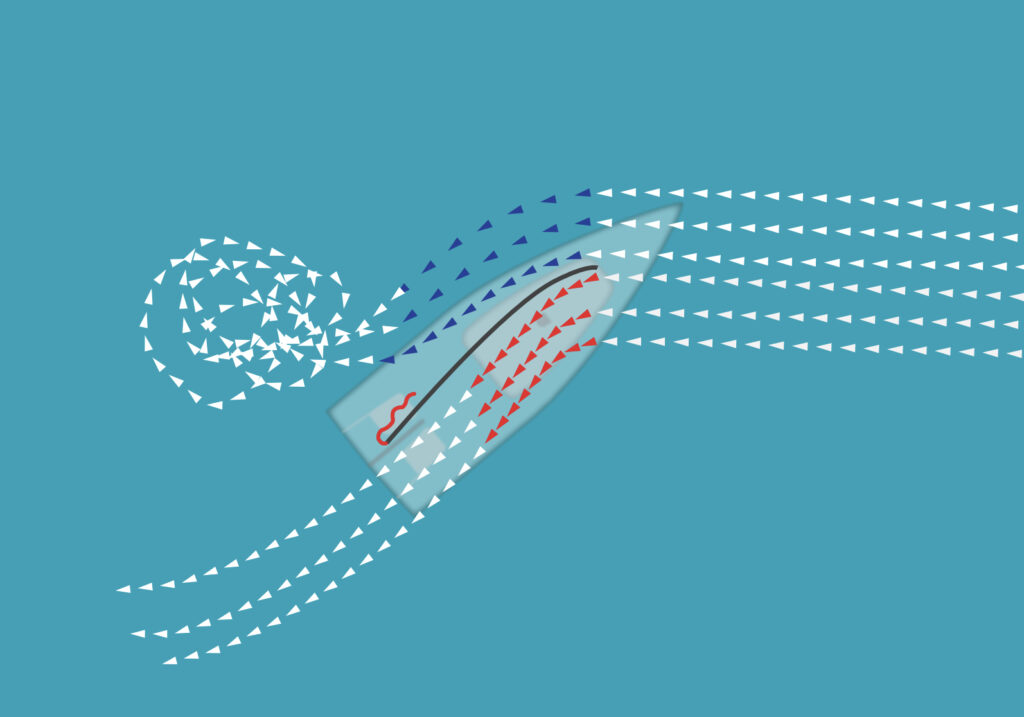If you’ve ever wondered how a sailboat moves forward – even when it’s not running with the wind – you’re not alone. It seems almost magical: a boat with no engine gliding to windward under nothing more than a sheet of cloth. But there’s a beautiful explanation behind it all, rooted in physics and refined by sailors over centuries. The secret? Lift.
The Theory of Lift on a Sail
Sails are not just fabric catching the wind like a parachute – they are airfoils, similar to airplane wings, that generate lift. As air moves across the curved surface of a sail, the flow behaves differently on each side. The air traveling along the leeward (outside) of the sail has to speed up to reach the trailing edge at the same time as the air on the windward (inside) side. According to Bernoulli’s Principle, the faster-moving air on the leeward side creates lower pressure, while the slower air on the windward side creates higher pressure. The result is a pressure difference that pulls the sail – and the boat – forward. This is lift.

The lift force acts nearly perpendicular to the sail, not directly forward. But when we combine this force with the resistance of the keel in the water, which also generates lift in its own way, we get a forward-driving component that moves the boat ahead – and a heeling component that tips the boat to one side.
For this to work, the sail needs to be positioned at just the right angle to the wind. This is called the angle of attack. If the angle is too small, the sail luffs uselessly. If it’s too large, the airflow separates, and the sail stalls – much like a plane wing losing lift.

Trimming the Sails: Applying the Theory
When sailing, our task is to control that airflow and keep the sails generating as much lift – and as little drag – as possible. This is where sail trim comes in.
Watch the telltales – those thin ribbons attached to the sail. If they flutter or droop, it tells you air isn’t flowing smoothly. On a properly trimmed sail, the telltales on both sides stream back parallel to the sail’s surface. This indicates smooth, attached flow and good lift.
The jib and main work together in fascinating ways. When trimmed correctly, the jib bends the air approaching the main sail – a phenomenon known as upwash. This helps the main generate even more lift without stalling. The two sails effectively act as two sides of a single, continuous foil, with airflow moving not just around them, but through the narrow slot in between. Sailors trim the jib slightly outboard and the main in toward centerline when sailing close-hauled, optimizing this interaction for maximum efficiency.
When trimming, small adjustments can make a big difference. If you want more power, increase the angle of attack slightly by easing the sheet or heading up. But go too far and you’ll stall the sail. Finding that balance takes practice and attention.
Using Lift Knowledge to Solve Problems on the Water
Understanding lift isn’t just a theory lesson – it’s a powerful tool when things aren’t going well.
Problem: You can’t point as high as the boat next to you.
Check your sail trim. Is your angle of attack too shallow? Is the jib trimmed too flat or too full? Are your telltales fluttering? Trim carefully and make sure you’ve got good flow across both sails. Also consider your speed: the keel won’t generate lift until there’s sufficient water flowing past it. Sometimes it pays to build up speed first, then start pointing higher.
Problem: Your sails look full, but you’re not moving fast.
You might have too much drag. Full sails increase power but can also increase turbulence. Try flattening the sails slightly or reducing twist. A clean keel matters too – marine growth on the keel can reduce its ability to generate lift just as effectively as a stalled sail.
Problem: The boat heels excessively in gusts.
Lift has a price: it causes heeling. When wind increases, reduce sail area, move the traveler to depower the main, or adjust your heading. Don’t fight the lift – just manage it.
Problem: You’re not getting the acceleration you expect after a tack.
Remember, lift takes flow. If you’re stuck slow after a tack, ease sheets slightly to get the sails working, build up some speed, and then trim harder to point higher. Don’t over-trim immediately – you’ll stall the sails before the keel has a chance to start generating lift again.
Finally, remember that the wind you feel on the boat – the apparent wind – is a blend of the true wind and your own boat’s motion. This is the wind that fills the sails and dictates your trim, and it changes constantly. That’s why good sailors are always watching, adjusting, and responding.
In Summary
Lift is the invisible hand that pulls a sailboat forward. It’s created by airflow over the sails and waterflow around the keel, and it depends on subtle balances of shape, angle, and speed. The better you understand it, the more you can shape your sails to the wind and turn invisible forces into graceful forward motion.
So next time you’re out on the water, watch the telltales, listen to the hum of the hull, and fine-tune those sheets. You’re not just pulling lines – you’re flying wings across the sea.
Want to Learn More?
The content in this article is from the ASA 102 textbook: Boat Handling & Sail Trim Made Easy, available in the American Sailing store.









